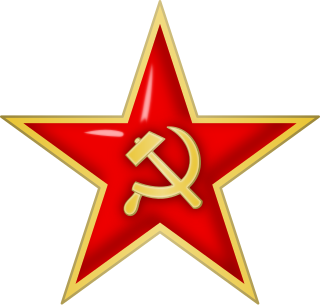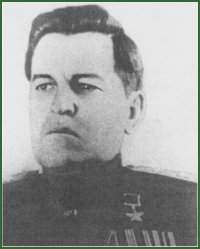The first version was created on July 24, 1941, from the right wing of the forces in the Western Front, including a new designation of the 3rd Army and the headquarters of the (disbanded) 4th Army, whose former HQ formed the Front headquarters. Colonel General Fyodor I. Kuznetsov took command.
The Front was a combination of the 13th and 21st Armies.
The new Front's air component was 136 aircraft (75 patched and repaired) under the command of Major General (Aviation) Grigory Vorozheikin. [2] The Central Front thus became the first new Front formed after the German invasion.
At the time the Front was created its boundary with the Western front was along the Bryansk-Roslavl-Shklov-Minsk line (all inclusive for the Western front), and the main operational direction of the front was along the Gomel–Bobruisk–Volkovysk axis. On August 1, 3rd Army joined the Front, and on August 7 Kuznetsov was recalled to Moscow to be given a new assignment. The command was transferred to General Mikhail Yefremov.
On August 8, Heinz Guderian's Panzergruppe 2 began its attack along the 13th Army sector. Four days later the German Second Army joined the attack. On August 17, the 63rd Rifle Corps was routed at the village of Skepnya (20 km to the east of Zhlobin), and two days later elements of the Second Army occupied Gomel. On August 22, the 3rd Army fell back from Mozyr. Under these blows the Front was eventually encircled and destroyed near Chernigov, and was formally disbanded on August 25, 1941. The surviving forces transferred to the first version of the Bryansk Front.
The second version of this Front was created on February 15, 1943, from the Don Front. Then Colonel General Konstantin K. Rokossovsky took command, and was promoted to full General in April 1943. Lieutenant General Mikhail Malinin was named as Front Chief of Staff, while Major General K.F.Telegin was made the member of the Front's Military Council.
The Front incorporated the headquarters and forces of the Don Front, plus additional armies were made part of the Front :
The Front's headquarters was established around 10 km to the east of Yelets.
As part of Stavka's general move to integrate and rationalise its Army Groups, the Front was renamed the 1st Belorussian Front on October 20, 1943.

The Western Front was a front of the Red Army, one of the Red Army Fronts during World War II.
The 3rd Army was a field army of the Red Army during World War II.

The 5th Guards Combined Arms Red Banner Army is a Russian Ground Forces formation in the Eastern Military District.
The Bryansk Front was a major formation of the Red Army during the Second World War.
A rifle corps was a Soviet corps-level military formation during the mid-twentieth century. Rifle corps were made up of a varying number of rifle divisions, although the allocation of three rifle divisions to a rifle corps was common during the latter part of World War II.
The 63rd Army was a field army established by the Soviet Union's Red Army during World War II.
The 3rd Shock Army was a field army of the Red Army formed during the Second World War. The "Shock" armies were created with the specific structure to engage and destroy significant enemy forces, and were reinforced with more armoured and artillery assets than other combined arms armies. Where necessary the Shock armies were reinforced with mechanised, tank, and cavalry units. During the Second World War, some Shock armies included armoured trains and air–sled equipped units.

The 10th Army of the Soviet Union's Red Army was a field army active from 1939 to 1944.
The Red Army's 33rd Army was a Soviet field army during the Second World War. It was disbanded by being redesignated HQ Smolensk Military District in 1945.
The 16th Army was a Soviet field army active from 1940 to 1945.
The Soviet 21st Army was a field army of the Red Army during World War II.
The Soviet 117th Rifle Division was a rifle division that served during the Second World War. Originally formed in 1939 destroyed and reformed during the war.
The 7th Guards Cavalry Corps of the Soviet Union's Red Army was a cavalry corps active during the Second World War. It was formed from the 8th Cavalry Corps in February 1943.
The 48th Army was a field army of the Soviet Red Army, active from 1941 to 1945. The army was first formed in August 1941 and fought in the Leningrad Strategic Defensive Operation. The army suffered heavy losses and was disbanded in early September. Its remnants were moved to the 54th Army. Reformed in April 1942 on the Bryansk Front, the army fought in the Maloarkhangelsk Offensive in the winter of 1943. It was sent to the Central Front in March and defended the northern face of the Kursk Bulge. During the summer, it fought in Operation Kutuzov and the Chernigov-Pripyat Offensive. From November, the army fought in the Gomel-Rechitsa Offensive. The army fought in Operation Bagration from June 1944. During the offensive, the army captured Zhlobin and Bobruisk and was on the Narew by early September. During early 1945, the army fought in the East Prussian Offensive and ended the war in East Prussia during May. The army was transferred to Poland in July 1945 and its headquarters was used to form the Kazan Military District in September.
The 50th Army was a Soviet field army during World War II. It was formed in mid-August, 1941 and deployed on the southwest approaches to Moscow. Partly encircled and destroyed by German Second Panzer Army in the opening stages of Operation Typhoon, enough of the army escaped that it could be reinforced to successfully defend the city of Tula in November. It was at this time that the 50th came under the command of Lt. Gen. Ivan Boldin, who continued in command until February, 1945. During most of its career the army was relatively small and accordingly served in secondary roles. It finished the war in East Prussia, under the command of Lt. Gen. Fyodor Ozerov, as part of 3rd Belorussian Front.
The 250th Rifle Division was the sixth of a group of 10 regular rifle divisions formed from cadres of NKVD border and internal troops as standard Red Army rifle divisions, very shortly after the German invasion, in the Moscow Military District. It was largely based on what would become the shtat of July 29, 1941, with several variations. It served under command of 30th Army in an effort to recover Smolensk in late July and in the Dukhovshchina offensives in August and September, and was quickly reduced to a much-weakened state. It was largely encircled in the initial stages of Operation Typhoon but sufficient men and equipment escaped that it was spared being disbanded and, in fact, it was partly rebuilt by incorporating remnants of other disbanded divisions. In October it played a relatively minor role in the defensive operations around Kalinin as part of 22nd Army in Kalinin Front. Early in 1942 the 250th was transferred to the 53rd Army of Northwestern Front, and spent most of the year rebuilding while also containing the German forces in the Demyansk Pocket. After this position was evacuated at the end of February, 1943 the division was transferred to the Reserve of the Supreme High Command and shipped south, joining the 2nd Reserve Army in Steppe Military District. This soon became the 63rd Army in Bryansk Front and the 250th was assigned to the 35th Rifle Corps, where it remained for the duration of the war. During the summer offensive against the German-held salient around Oryol the division helped lead the drive to liberate that city in August, and then advanced through western Russia and into Belarus, now in Central Front. In the initial phase of Operation Bagration the division, now in 3rd Army, was given special recognition for its role in the liberation of the city of Babruysk, and shortly thereafter also received the Order of the Red Banner and the Order of Suvorov. During 1945 it moved, with its Corps and Army, from 2nd Belorussian to 3rd Belorussian Front before returning to 1st Belorussian, seeing combat in Poland, East Prussia and central Germany; its subunits were awarded additional honors and decorations during this period. The 250th had a distinguished career as a combat unit, ending its combat path along the Elbe River. It was disbanded in Belarus in July 1946.
The 323rd Rifle Division was formed as a standard Red Army rifle division late in the summer of 1941, as part of the massive buildup of new Soviet fighting formations at that time. After a successful but costly start in the Soviet winter counteroffensive in the Tula region the division served on relatively quiet sectors into 1943, after which it joined the offensive push into German-occupied western Russia through the rest of that year, winning a battle honor for the liberation of Bryansk. In the course of the destruction of Army Group Center in the summer of 1944, the division further distinguished itself in the liberation of Bialystok in July. In 1945 the men and women of the 323rd took part in the Vistula-Oder Offensive through Poland and into Pomerania, and then finally in the Battle of Berlin, ending the war with distinction, but being disbanded soon after.

The 348th Rifle Division was first formed in August 1941, as a standard Red Army rifle division, at Kuibyshev. It was assigned to 60th Reserve Army shortly after forming and took part in the winter counteroffensive in front of Moscow. Until the end of 1942 it was involved in the dismal and costly battles around the Rzhev Salient, until it was shifted to take part in the equally difficult fighting around the Demyansk Salient. Both of these German positions were evacuated in March 1943, and, after rebuilding, the division returned to the front to take part in the summer offensive along the Smolensk axis. During Operation Bagration the 348th distinguished itself in the liberation of Bobruisk, and received the name of that city as an honorific. Not long after it was also decorated for its role in the liberation of Bialystok. In 1945 it helped to liberate northern Poland during the Vistula-Oder Offensive, before being reassigned to 3rd Belorussian Front in East Prussia. In the last weeks of the war it formed part of the reserves of 1st Belorussian Front during the Berlin Operation.
The 397th Rifle Division was an infantry division of the Red Army, active twice during 1941-45, fighting the German Operation Barbarossa.




